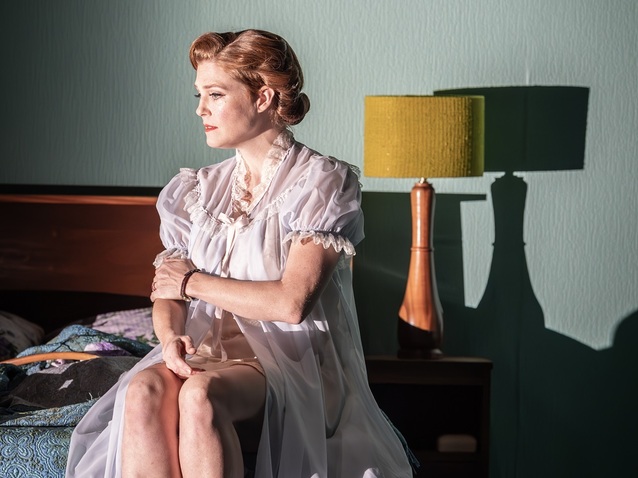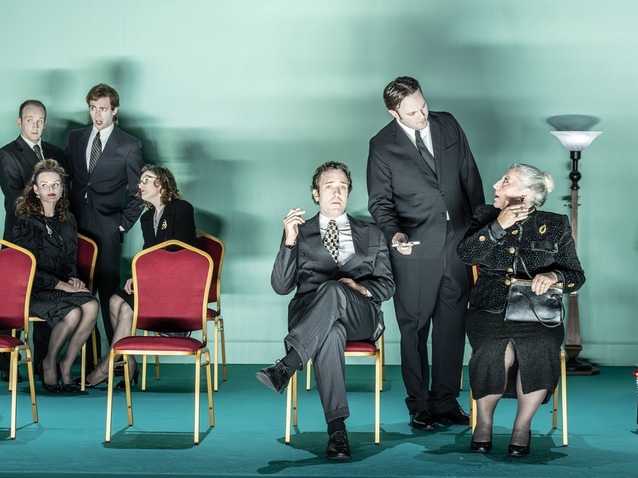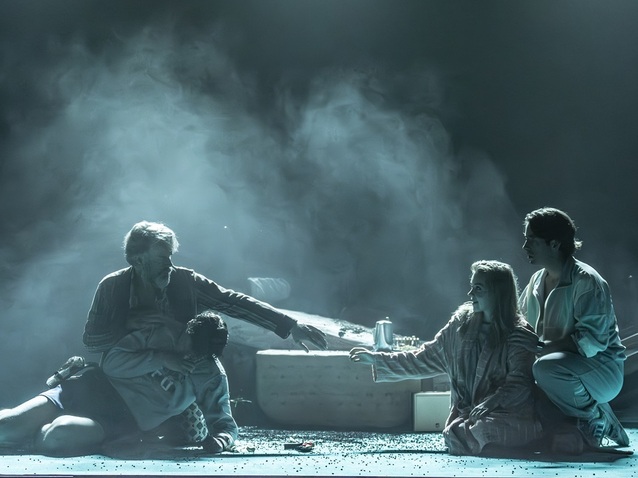 © Marc Brenner / The Royal Opera
© Marc Brenner / The Royal Opera
Leonard Bernstein composed his one act opera Trouble in Tahiti in 1952, and on this occasion wrote the libretto himself. It concerns a married couple who on the surface have it made with their beautiful suburban home, but who find it difficult to live with each other and constantly bicker and fight. In 1983 he wrote A Quiet Place, which considers where the same family’s members are thirty years later. While performing both in the same evening would seem an obvious thing to do, in reality it does not happen that frequently, making this current outing at the Royal Ballet and Opera a welcome opportunity to experience the pair together.
Trouble in Tahiti considers Sam, a businessman who sees himself as one of life’s winners, and his wife Dinah. They live in a seemingly idyllic suburban house, but are not happy together, and the way in which the opera plays out the dysfunctional nature of their relationship feels very realistic. In particular, the manner in which they find any tiny thing triggering another argument between them, even though they both realise it is ridiculous to fight over such trivial matters, is highly believable.
The opera’s title derives from the film that Dinah misses her son’s play to see. She deems it to be unadulterated drivel, but as she describes its plot she becomes increasingly infatuated with it because it presents the type of love and magic that is so lacking in her own life. The opera ends with the couple agreeing they need to talk and sort things out, but one suspects they reach the same conclusion every day of their life and that things still go on as before. In the short term, at least, they decide to head to see this movie once more, thus escaping into fantasy rather than facing up to their own reality.

Wallis Giunta (Dinah) in Trouble in Tahiti, The Royal Opera © 2024 Marc Brenner
The Royal Ballet and Opera’s Director of Opera Oliver Mears’ new production takes place in the venue’s smaller Linbury Theatre. This proves to be the perfect size for such an intimate piece, and Annemarie Woods’ set, which presents the ‘clean cut’ interior of the couple’s house, looks just like an Edward Hopper painting. This could not be more appropriate because his pictures are all about detachment and isolation in situations where those feelings should not be as present as they are. When Sam contemplates what a winner he is at the gym, he does so as a boxer at a punchbag. With Fabiana Piccioli’s lighting designs creating several shadows of him, it feels as if we are witnessing boxers facing each other in the ring. As a result, the paintings of George Bellows spring to mind, which ostensibly portray strength, courage and heroism, but in reality are about people struggling to survive.
The opera also sees a jazz trio interject on occasions, cheerfully singing about ‘The American Dream’ that contrasts so markedly with Sam and Dinah’s situation. On this occasion, the three singers (a splendid Kirsty McLean, Guy Elliott and Peter Edge) pop up from behind the house’s wall, with the act of placing them high above the mundane proceedings introducing another dimension again. Wallis Giunta is extremely experienced in the role of Dinah, having also played it for Opera North in 2017 in a production that was subsequently broadcast on Sky Arts. It is a part she has very much made her own as her expressions and gestures feel astutely observed, while her mezzo-soprano seems to fit the character she is playing like a glove. Henry Neill is equally accomplished as Sam as he combines a strong and secure baritone with what might best be described as a troubled cockiness.

A Quiet Place, The Royal Opera ©2024 Marc Brenner
A Quiet Place examines where Sam and Dinah are thirty years later. They now have two grown up children, one of whom was referred to in Trouble in Tahiti, and Dinah has just died in a car crash. The story opens on Dinah’s funeral, which sees plenty of bickering among family members, friends and professional acquaintances, before focusing more on the immediate family. Its members all have an uneasy relationship as Sam’s daughter Dede is now married to François, who had previously had a relationship with his son Junior. Junior also has mental health issues that manifest themselves in ways that antagonise Sam. The remainder of the opera sees various combinations of the four share tender memories alongside more confrontational moments. The piece does, however, end with a quiet sense of hope as all four accept that they need to learn to communicate with each other.
The opera was not well received when it premiered in 1983, also in a double bill with Trouble in Tahiti, and it is possible to see why. With Tahiti being so strong and possessing such intriguing characters, it is understandable why Bernstein should want to write another work to consider what became of them. However, as with many film sequels, it seems as if he could not quite capture the precise ingredients that made the ‘original’ such a classic. It certainly feels that in an effort to build on what went before and take it a step further, everything from the characters to the confrontations feels more overblown, so that the opera comes across as more stark and less subtle.

A Quiet Place, The Royal Opera ©2024 Marc Brenner
Following the premiere, Bernstein and librettist Stephen Wadsworth rewrote the opera, creating a three act version that incorporated Trouble in Tahiti into Act II via two flashbacks. This being the case, performances of the original version have been scarce ever since. For this reason, the chance to see both operas together in their ‘original’ form (here they both utilise Garth Edwin Sunderland’s extremely successful reduced orchestration) should be embraced, especially as it is hard to picture them being presented any better.
With A Quiet Place also directed by Mears, Woods’ set is essentially the same as for Trouble in Tahiti, only now its back wall is sometimes removed. Although this is partly in response to the drama’s specific requirements, it also reveals the contrast between the still predominantly domestic nature of the first opera, and the more desolate feel of the second as a dark void seems to lie beyond the room. There are also a host of effective touches, with shadows of the figures in the first scene feeling slightly blurred so that the resulting images look like the paintings of Gerhard Richter.
The cast could hardly be bettered with Grant Doyle as Sam, Henry Neill now as his son Junior, Rowan Pierce as Dede and Elgan Llŷr Thomas as François creating powerful dynamics as they fight and spar. The first scene at the funeral also features some excellent ‘cameos’, not least from Sarah Pring as the acerbic Mrs Doc. Nicholas Chalmers’ conducting is outstanding across both works, with the consequence that, even if the second opera is not without its defects, the evening as a whole still stands as something quite special.
By Sam Smith
the 13 of October, 2024 | Print
Comments